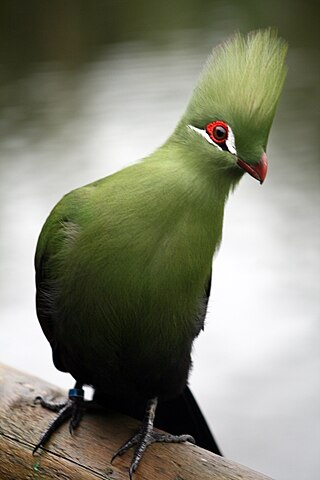
The turacos make up the bird family Musophagidae ( "banana-eaters"), which includes plantain-eaters and go-away-birds. In southern Africa both turacos and go-away-birds are commonly known as loeries. They are semi-zygodactylous: the fourth (outer) toe can be switched back and forth. The second and third toes, which always point forward, are conjoined in some species. Musophagids often have prominent crests and long tails; the turacos are noted for peculiar and unique pigments giving them their bright green and red feathers.

The white-bellied go-away-bird is a bird of eastern Africa in the family Musophagidae, commonly known as turacos.

The great blue turaco is a bird species of the family Musophagidae. At 70–76 cm (28–30 in) in length, it is the largest species of turaco. It has predominantly grey-blue plumage with an upright blue-black crest around 10 cm (3.9 in) high. The male and female have similar plumage. It is widespread throughout the African tropical rainforest.
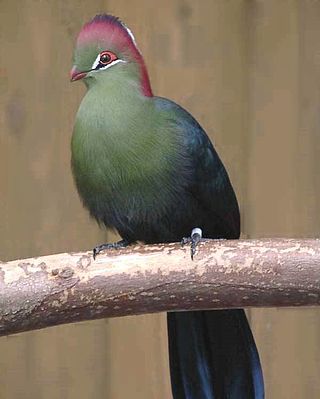
Tauraco is a genus of turacos. It contains the "typical" or green turacos; though their plumage is not always green all over, the presence of significant amounts of turacoverdin-colored plumage generally sets Tauraco species apart from other Musophagidae. Indeed, as opposed to any other known birds, Tauraco turacos are the only living bird taxa that have any significant green pigment whatsoever, as the greens of many parrots etc. are due to structural color, not pigment. Their genus name was derived from a native West African name.
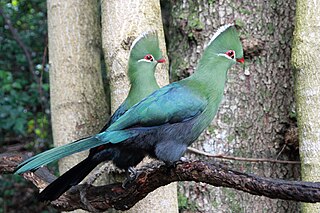
The Knysna turaco, or, in South Africa, Knysna loerie, is a large turaco, one of a group of African musophagidae birds. It is a resident breeder in the mature evergreen forests of southern and eastern South Africa, and Eswatini. It was formerly sometimes considered to be a subspecies of the green turaco of West Africa. The Livingstone's and Schalow's turacos were once considered subspecies.

The bare-faced go-away-bird is a species of bird in the family Musophagidae which is native to the eastern Afrotropics. It is named for its distinctive and uniquely bare, black face.

Ross's turaco or Lady Ross's turaco is a mainly bluish-purple African bird of the turaco family, Musophagidae.

The Rwenzori turaco is a bird in the family Musophagidae. It is native to the Albertine Rift montane forests.

Fischer's turaco is a species of bird in the family Musophagidae. It is found in Coastal East Africa, including Kenya, Somalia, and Tanzania. Its natural habitats are subtropical or tropical moist lowland forest, subtropical or tropical moist montane forest, and arable land. It is threatened by habitat loss and trapping for the wildlife trade.

Hartlaub's turaco is a species of bird in the family Musophagidae. It is found in Kenya, Tanzania, and Uganda.
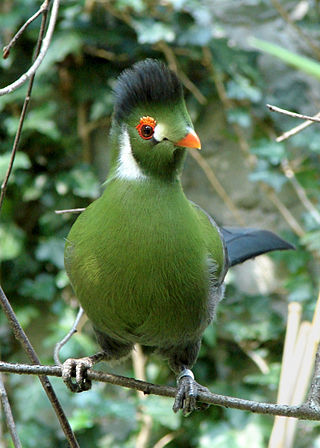
The white-cheeked turaco is a species of bird in the family Musophagidae. It is found in Eritrea, Ethiopia, and South Sudan. A mid-sized species, it measures about 43 cm (17 in) in length, including a tail of 19 cm (7.5 in), and weighs about 200–315 g (7.1–11.1 oz). This species is the most commonly raised turaco in captive conditions.
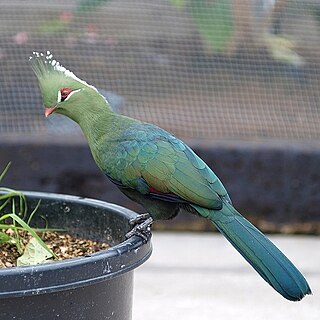
Livingstone's turaco is a species of bird in the family Musophagidae, which was named for Charles Livingstone, the brother of David Livingstone.

The yellow-billed turaco is a species of bird in the family Musophagidae. It is found in Angola, Cameroon, Republic of the Congo, Democratic Republic of the Congo, Ivory Coast, Equatorial Guinea, Gabon, Ghana, Guinea, Liberia, Nigeria, and Sierra Leone.

The purple-crested turaco or, in South Africa, the purple-crested loerie, (Khurukhuru in the Luvenḓa language is a species of bird in the clade Turaco with an unresolved phylogenetic placement. Initial analyses placed the purple-crested turaco in the family Musophagidae, but studies have indicated that these birds do not belong to this family and have been placed in the clade of Turacos with an unresolved phylogeny. It is the National Bird of the Kingdom of Eswatini, and the crimson flight feathers of this and related turaco species are important in the ceremonial regalia of the Swazi royal family.

Ruspoli's turaco, also known as Prince Ruspoli's turaco, is a species of bird in the family Musophagidae. It is endemic to southern Ethiopia where its natural habitat is subtropical or tropical dry forests. It is threatened by habitat loss.

Schalow's turaco is a frugivorous bird in the family Musophagidae. This bird's common name and Latin binomial commemorate the German banker and amateur ornithologist Herman Schalow.

Crinifer is a genus of birds in the turaco family. They are restricted to Africa. Formerly, the genus only contained the plantain-eaters, but in 2021, go-away-birds were merged into the genus.

Turacoverdin is a unique copper uroporphyrin pigment responsible for the bright green coloration of several birds of the family Musophagidae, most notably the turaco. It is chemically related to turacin, a red pigment also found almost exclusively in turacos. Turacoverdin is one of the only true green pigments found in birds, as the coloration that appears in most green feathers is due to the unique properties of blue structural coloration in combination with yellow carotenoids. Turacoverdin and turacin were the first ever chemically characterized feather pigments, and turacoverdin was first isolated and described in 1882 by Dr. C.F.W. Krukenberg.
Zenker's turaco, is a subspecies of the Guinea turaco. It is a green turaco, in the family Musophagidae, subfamily Tauracinae, a group of near-passerines birds. Zenker's turaco is found in forests of Central Africa in the Congo Basin in Gabon, DR Congo and Congo-Brazzaville and south to northern Angola. It forms part of a superspecies complex that extends from West Africa to East Africa and as far south as the Cape in Southern Africa and include the black-billed turaco, Emin's turaco, Schalow's turaco, Livingstone's turaco, the Transvaal turaco and the Knysna turaco, as subspecies within the group.

Menelikornis is a genus of African birds in the family Musophagidae.






















